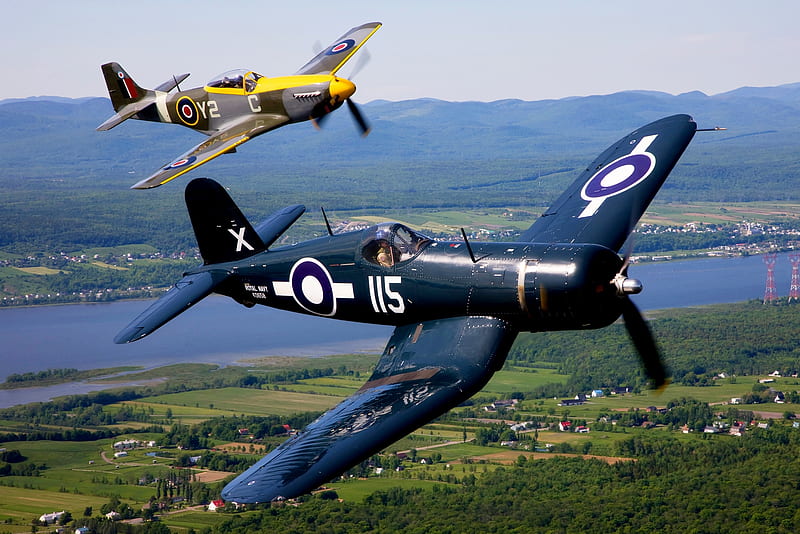In the annals of World War II aviation history, two aircraft stand out as icons of air superiority: the North American P-51 Mustang and the Vought F4U Corsair. Each of these planes was a product of cutting-edge engineering and design, and both played pivotal roles in the success of Allied forces during the conflict. Their storied careers and distinct characteristics have cemented their places in aviation lore, and a comparison of these two legendary fighters offers a fascinating glimpse into the evolution of aerial combat.
![Class of 45's P-51 Mustang and F4U Corsair! [2256x2256] : r/WarplanePorn](https://i.redd.it/rw3ojbc2tpz61.jpg)
The P-51 Mustang: A Marvel of Engineering
The P-51 Mustang, introduced in 1942, is often hailed as one of the most effective fighters of World War II. Designed initially to meet the urgent need for a high-performance fighter, the Mustang quickly surpassed expectations with its remarkable speed, range, and agility. Its design was spearheaded by North American Aviation, with the goal of creating a fighter that could escort bombers deep into enemy territory and provide protection against enemy fighters.
Powered by the Packard-built Merlin engine, the P-51 Mustang boasted an impressive top speed of around 440 mph and a range that exceeded 1,000 miles, thanks to its large fuel tanks. This combination of speed and endurance allowed the Mustang to escort bombers on long-range missions, a critical factor in the strategic bombing campaign over Europe. Additionally, its well-balanced airframe and responsive controls made it a formidable dogfighter, capable of taking on the best the Axis powers had to offer.
One of the Mustang’s most notable achievements was its role in the Luftwaffe’s defeat. The presence of the P-51 in the skies over Europe significantly diminished the effectiveness of German fighters, providing Allied bombers with much-needed protection and contributing to the eventual victory in the air war.

The F4U Corsair: The King of the Pacific Skies
On the other side of the globe, the Vought F4U Corsair was making its mark in the Pacific Theater. Introduced in 1940, the Corsair was renowned for its distinctive gull-wing design, which was both functional and aesthetically striking. The design choice allowed for a larger, more powerful engine and better ground clearance for the aircraft’s large propeller, essential for the Corsair’s role in carrier operations.
Equipped with the Pratt & Whitney R-2800 Double Wasp engine, the F4U Corsair achieved a top speed of approximately 440 mph, similar to the Mustang. However, it was its firepower and ruggedness that set it apart. The Corsair was armed with six .50 caliber machine guns and had the capability to carry bombs or rockets, making it a versatile tool for both air-to-air combat and ground attack missions. Its robust construction and heavy armor allowed it to withstand considerable damage and continue flying, a vital trait for carrier-based operations where repairs were often challenging.
The Corsair’s effectiveness was evident in its combat record. It was instrumental in establishing air superiority over Japanese forces and played a crucial role in the successes of the U.S. Navy and Marine Corps in the Pacific. The aircraft’s ability to operate from the challenging conditions of aircraft carriers, combined with its impressive firepower, made it a formidable opponent and a favorite among its pilots.

Comparing Legends
While both the P-51 Mustang and F4U Corsair were exceptional aircraft, their differing roles and theaters of operation highlight their unique contributions to the Allied victory. The Mustang’s long-range escort capabilities and agility made it a critical asset in Europe, while the Corsair’s power, versatility, and resilience were vital to the Pacific campaign.
In essence, the P-51 Mustang and F4U Corsair represent the pinnacle of World War II fighter design, each excelling in its own domain. The Mustang’s sleek design and superior range were matched by the Corsair’s rugged durability and potent armament. Together, they embody the technological advancements and strategic innovations that defined aerial combat during the war.

As we look back on these aviation legends, it’s clear that the P-51 Mustang and F4U Corsair were more than just machines; they were symbols of Allied air power, each contributing in its own way to securing victory in one of the most pivotal conflicts in history. Their legacy endures in the annals of aviation history, a testament to the skill and determination of the engineers, pilots, and crews who brought these remarkable aircraft to life.





